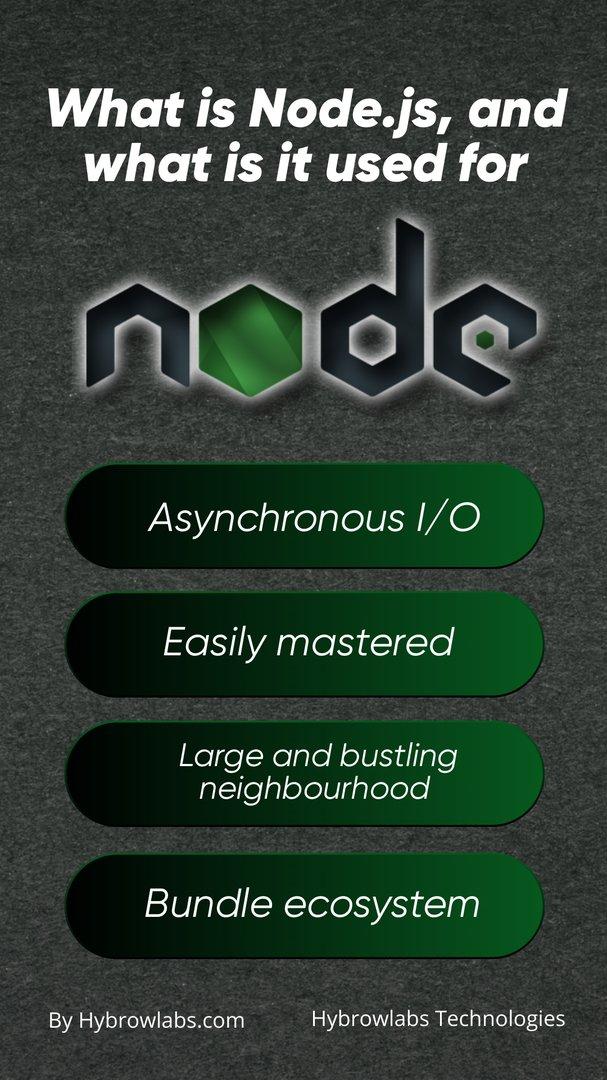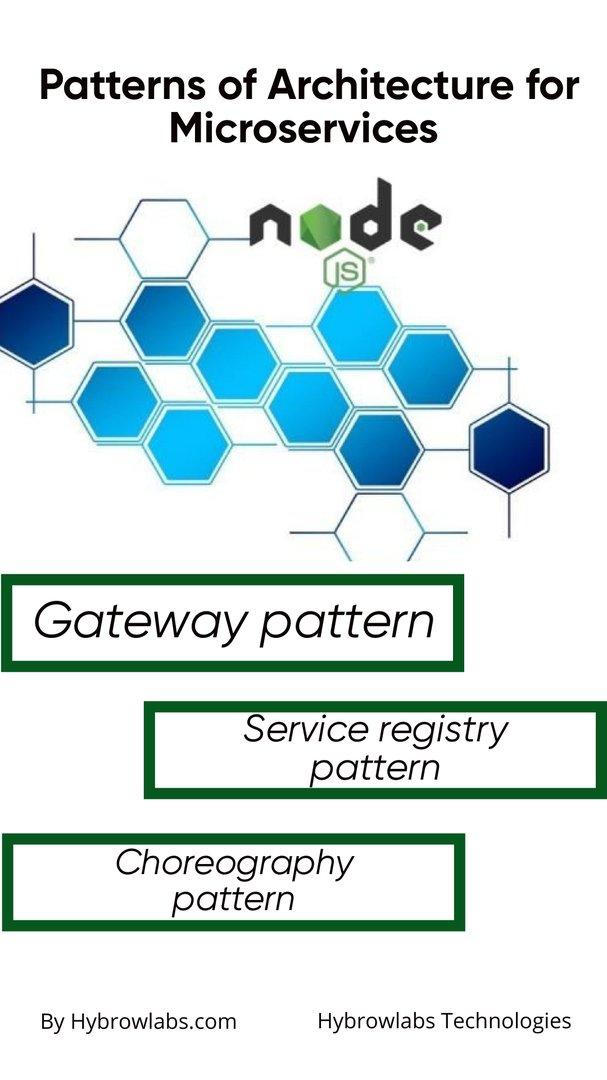Introduction
For developers, Node.js has changed the game by providing a robust framework for creating high-performance web apps. In recent years, Node.js and microservices have gained popularity, making it easier and more scalable for developers to create and deploy sophisticated systems.
A scalable and maintainable architecture is more necessary as software applications' complexity rises. Building scalable apps has become increasingly popular thanks to microservices design. The development and deployment of microservices-based applications using Node.js, along with architecture principles, communication protocols, and containerization, will be covered in this article.
What is Node.js, and what is it used for?

Built on top of the Google Chrome web browser's V8 engine, Node.js is a server-side JavaScript runtime environment. It allows developers to utilize JavaScript for server-side scripting, which was previously restricted to languages like Python and PHP.
Web servers, real-time apps, and microservices are all frequently built using Node.js, a scalable network application development platform. It offers several crucial characteristics that make it ideal for specific use cases, including:
1. Asynchronous I/O
Js is highly effective and scalable for managing many requests because of its event-driven, non-blocking I/O style.
2. Easily mastered
JavaScript is a well-liked programming language for creating client-side applications, and Node.js is simple to learn for developers who are already familiar with it.
3. Large and bustling neighbourhood
Node.js's sizable and vibrant developer community actively participates in its continuing development, ensuring it constantly improves.
4. Bundle ecosystem
A sizable ecosystem of packages and modules for Node.js is simple to use and install in apps.
What are Microservices?
An architectural method known as microservices divides systems into small, independently deployable services that can communicate with one another via a network. Each microservice may be independently built, tested, and deployed since it is concentrated on a single, narrow task or functionality.
Why use Node.js for Microservices?
A well-liked JavaScript runtime called Node.js enables programmers to create scalable, high-performance apps. Due to its non-blocking I/O approach, which enables effective management of numerous simultaneous connections, it is highly suited for developing microservices-based systems. Furthermore, Node.js has a sizable and vibrant community, and numerous modules and frameworks are available to make creating microservices-based systems easier.
Patterns of Architecture for Microservices

Because it enables the decoupling of various components of an application into more minor, independent services, microservices architecture has become a popular strategy for developing large-scale applications. Teams may operate more productively and autonomously with the help of this method, which also offers flexibility and scalability when handling complicated systems.
Several architecture patterns in Node.js can be utilized for the creation of microservices. The most well-liked patterns include:
1. Gateway pattern
This design style uses a single access point for all microservices—a centralized API gateway. It handles routing, security, and other overarching issues so that each microservice may concentrate on its primary capabilities.
2. Service registry pattern
This design pattern uses a centralized service registry to keep track of the networks where each offered microservice is located. It provides load balancing and failover as well as dynamic service discovery.
3. Choreography pattern
This pattern uses a decentralized method in which one microservice interacts with other microservices directly to carry out a task. Although flexible and loose coupling is enabled, larger applications may find it more challenging to manage.
Communication Protocols for Microservices
Microservices architecture success depends on efficient communication. Several communication protocols are available in Node.js to facilitate communication between microservices. The most well-liked protocols include the following:
1. REST
Representational State Transfer, sometimes known as REST, is a popular protocol for creating online APIs. It is simple to use and comprehend and uses HTTP requests to communicate data between the client and server.
2. gRPC
Protocol Buffers are the data format used by the high-performance, open-source RPC framework known as gRPC. It is perfect for microservices architecture because it supports various languages and platforms and offers effective binary serialization.
3. MQTT
The MQTT Message IoT and real-time applications benefit significantly from the lightweight messaging protocol known as Queuing Telemetry Transport (MQTT). Its low latency and bandwidth utilization make it appropriate for use in areas with limited resources.
Containerization for Microservices
Because containerization offers a portable and lightweight runtime environment, it has grown in popularity as a method of packaging and deploying microservices. Being a well-liked containerization technology for Node.js, Docker gives developers an easy and effective approach to package and deploy their applications.
The creation, configuration, and deployment of Docker containers are simple and may be used on any platform that supports Docker. It enables smooth deployment between various environments, including development and production.
Deployment Strategies for Microservices
For a microservices architecture to be successful, effective deployment mechanisms are essential. To enable seamless and effective deployment of microservices, Node.js offers several deployment strategies.
1. Blue-green deployment
A new programme version is deployed to a different environment (green) using the blue-green deployment technique, while the current version remains active in the production environment (blue). Traffic is moved to the new environment as soon as the new version is tested and ready.
2. Canary deployment
Canary deployment is rolling out a new programme version to a small group of users while continuing to utilize the previous version for everyone else. It makes testing and validating the new version possible before making it available to all users.
Building Microservices with Node.js
A multiple application is divided into more minor, autonomous services utilizing the architectural style known as microservices, which can communicate with one another via APIs. Due to its scalability, performance, and usability, Node.js is preferred for developing microservices.
To create microservices using Node.js, follow these steps:
1. Set the bounds of the services.
Choose the components of your application that can be divided into more compact, separate services.
2. Picking a protocol for communication
Decide the microservices' means of communication. Although RESTful APIs are frequently used for inter-microservice communication, other choices include gRPC, GraphQL, and WebSockets.
3. Utilize a structure
Several Node.js frameworks, including Express.js, Hapi.js, and Nest.js, can facilitate the development of microservices.
4. Create a layer for data storage.
Choose your data storage strategy for microservices. A single database for all microservices or a different one for every microservice is an option.
5. Put the microservices in containers.
Using a containerization technology like Docker, package the microservices into containers that can be quickly deployed and controlled.
6. Put continuous integration and deployment into practice.
For your microservices, automate the build and deployment procedures by using a technology like Jenkins, CircleCI, or TravisCI.
7. Keep an eye on and oversee the microservices.
To control the scalability and performance of your microservices, use tools like Kubernetes, Prometheus, and Grafana.
In general, Node.js microservice development calls for careful planning and architecture to guarantee that each service can efficiently communicate with one another and be easily maintained and scaled.
Benefits of microservice architecture

A significant application is divided into more minor, autonomous services that can connect through APIs in a software development process known as microservice architecture. Comparing this strategy to conventional monolithic architectures, it has various advantages. Some of the main advantages of the microservice architecture are as follows:
1. Scalability
Because microservices may scale independently, resources can only be used where needed. This results in enhanced performance and better resource management.
2. Resilience
Microservices are made to be failure-resistant. Only that service is affected when one fails, not the entire system. As a result, the system is more fault-tolerant.
3. Agility
Because Agility Microservices are independent of one another, modifications to one service do not affect the system as a whole. As a result, teams may deliver updates more frequently and quickly without impacting the application as a whole.
4. Technology diversity
Microservices can be created using a variety of technologies and programming languages. Thanks to this, teams can choose the optimal technology for each service without being limited by decisions made for other application components.
5. Simple to comprehend and manage
Microservices are easier to comprehend and maintain since they are more compact and straightforward than monolithic applications. The management of each service can be delegated to a different team, which lightens the burden on individual developers.
6. Strengthened fault isolation
Microservices are independent of one another, which isolates defects to specific services, making it simpler to find, identify, and fix problems.
Huge applications can be built and maintained using a flexible, scalable, and resilient microservice architecture. Also, it simplifies maintenance and deployment, promoting quicker innovation and quicker speed to market for companies.
Drawbacks of microservice architecture
Although microservice architecture has many advantages, certain disadvantages must be considered before using this strategy. The following are some of the significant issues with microservice architecture:
1. Complexity
The development process is made more difficult by microservice architecture. Coordination between numerous teams and services is necessary to develop a microservice-based system, which might be challenging.
2. Increased costs
Microservices involve more work, such as load balancing, service discovery, and communication protocols. The system's complexity and price may rise as a result.
3. Testing
Microservice testing can be complex because it calls for testing each service separately and integrating the services. The length and cost of the test may go up as a result.
4. Telephone overhead
Microservices rely highly on inter-service communication, which can increase network traffic and communication overhead.
5. Operational difficulty
A microservice-based system can be trickier to maintain and monitor than a monolithic one. Because each service must be maintained and monitored separately, there may be an increase in operational workload.
6. Handling of data
Data consistency and integrity might be more difficult if data is split over several microservices.
Ultimately, developing large, sophisticated applications can benefit significantly from microservice architecture, but it also introduces additional complexity and overhead that must be adequately controlled. Before selecting whether to use this strategy, organizations must balance its advantages and disadvantages.
Conclusion
Node.js provide a robust and adaptable platform for creating microservices-based applications. It is ideal for creating scalable and high-performance applications due to its non-blocking I/O model and vibrant community. Developers can create scalable and maintainable microservices-based applications by adhering to the necessary architecture principles, communication protocols, and containerization strategies and all this can be easily achieved by choosing Hybrowlabs Node.js Development Services for creation of applications
FAQ's
1. Why is Node.js a preferred platform for creating microservices?
A: Because of its scalability, performance, and user-friendliness, Node.js is a popular choice for developing microservices. It is suitable for building event-driven, non-blocking applications that manage numerous concurrent requests.
2. What are Node.js frameworks available for creating microservices?
A: Many frameworks, such as Express.js, Hapi.js, and Nest.js, are available for Node.js microservice development.
3. How can I manage and deploy Node.js-based microservices?
A: Containerization tools like Docker and Kubernetes can be used to deploy and manage Node. Js-based microservices. They can also be maintained through programmes like Jenkins, Grafana, and Prometheus.
4. Can I create real-time microservices using Node.js?
A: Due to its event-driven, non-blocking architecture, Node.js is a good choice for developing real-time microservices. Socket.io and Sails.js are two well-liked Node.js frameworks for creating real-time microservices.
5. How can I test Node.js-based microservices?
A: Testing Node. Js-based microservices include testing the integration between the services and each service separately. Mocha, Jest, and Chai are a few of the well-liked Node.js testing frameworks.






a3dc85.jpg)

.jpg)
fd8f11.png)


.jpg)
.jpg)